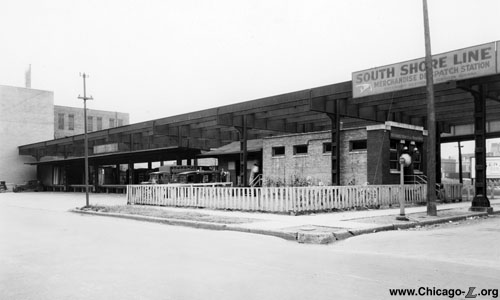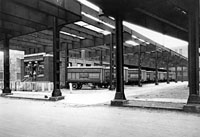.

The steel elevated structure that once held the Union Avenue Yard is seen stripped of tracks and any other infrastructure on October 16, 1929, looking southwest on the corner of Union Avenue and 41st Street. The land underneath the elevated structure is being used for a merchandise dispatch and less-than-carload freight facility for the Insull interurban railroads, as advertised on the sign on the steel structure over 41st Street. For a larger view, click here. (Photo courtesy of the Illinois Railway Museum, North Shore Line Collection) |
Union Avenue
Yard
Union Avenue and 41st
Street, New City
Service
Notes:
|
Located:
|

|
South Side Elevated, Stock Yards
Branch
|
Quick Facts:
Address: TBD
Established: April 8, 1908
Yard Area: unknown
Rebuilt: n/a
Status: Demolished
On April 8, 1908, the Stock Yards branch of the South Side Elevated opened between Indiana station and the famous Stockyards. As the branch headed west from Indiana, it made
a zigzag south just west of Union Avenue for a
little more than a block before turning west again toward the yards. At the west end in the
Stockyards, the branch ended in a single track loop around the
"Packingtown" section of the yard, where most of the companies had
their meat packing plants.
Construction of the branch included the provision of a small car storage yard and maintenance facility, located where the branch made the turn. The entrance to the yard from the main line was a short distance west of Wallace station, just before the tracks curved south, at what would be 40th Street and Union Avenue (although no street actually existed at 40th there, the alignment having been vacated and occupied by the Chicago Junction Railway and "L" line). From there, the elevated yard tracks, supported by its own steel "L" structure, ran parallel to and between the north-south main line tracks and Union Avenue, crossing over 41st Street. The facilities were described by Street Railway Journal:
"At Union Avenue the South Side Elevated is building on its own account a large elevated storage yard connecting with the structure at the north end. It has six long stub tracks and one shorter one and will have a capacity of 60 cars. An interlocking tower and trainmen's house will be built here and provision made for inspection of equipment by inspection pits below the floor of the structure." 1
More than a pit, the Union Avenue Yard actually had a one-track inspection shop built on the easternmost track in the yard. Perhaps this building was the "trainmen's house" mentioned in the article.
However, the whole endeavour appears to have been unnecessary -- there is no record that the Union Avenue yard or shop was used on a regular basis.
By 1913, a company training manual for trainmen related to through-routing of trains noted that the interlocking plant controlling access to the yard from the main line tracks of the Stock Yards branch was not in operation and the arms on the signals had been removed. This suggests most likely that the yard was not in service, or at the very least that it was used so infrequently that moves were handled by manually throwing switches.
A 1919 valuation report from the Illinois Public Utilities Commission stated that, by that point, the tracks in the yard had already been removed, showing that the yard had been completely removed from service some time prior.
Interestingly, the Union Avenue Yard was built with both a larger capacity and an inspection shop compared to the 50-car shop-less yard built at 42nd Place on the Kenwood branch, whose facilities were actually used.

A merchandise dispatch office is seen under the former Union Avenue "L" yard elevated structure on October 16, 1929. The motor trucks labeled for the North Shore Line lined up along the freight station were used to ferry freight received here to the Montrose Avenue station, where it was loaded onto interurban cars for transport. The elevated structure on the right is the Stock Yards branch main line. For a larger view, click here. (Photo courtesy of the Illinois Railway Museum, North Shore Line Collection) |
By the 1920s, the Union Avenue Yard consisted of a steel elevated structure skeleton with no actual yard facilities. The property, however, was found to have a useful secondary purpose for the corporate interests controlled by Samuel Insull, whose portfolio included not only the "L" but also three Chicago area electric interurban railroads. Two of the interurbans -- Chicago North Shore & Milwaukee and Chicago Aurora & Elgin -- ran over the "L" into Chicago using trackage rights, and in addition to passengers also provided some level of freight service. The North Shore Line and CA&E carried items such as newspapers, baggage, and express and
less-than-carload (LCL) merchandise dispatch (spelled "despatch" on company signage, equipment and documents rather
than "dispatch", owing to Chairman Samuel Insull's British heritage)
in regular interurban passenger cars,
combination passenger/baggage cars, or special freight cars, depending on the type of freight, that conformed to
"L"/interurban clearances and specifications. A freight house and loading terminal was established in 1919 on the North Side of Chicago at Montrose Avenue, at ground level at the south end of the "L"'s Wilson Yard property, where the LCL freight was loaded onto the interurban's cars. Satellite offices were established around the city to provide convenient drop-off points for customers, from which the parcels were shuttled to the Montrose facility by truck. The under-utilized yard property at Union and 41st provided a convenient and free location on which to establish such a receiving office. Electric Railway Journal described the establishment of the merchandise dispatch office at Union and 41st:
"Since Feb 15 1922, the Chicago North Shore & Milwaukee Railroad has been operating its Milwaukee limited trains through the loop to Sixty-third Street and Woodlawn Avenue on the south side providing an hourly service for south side business men and residents to and from Milwaukee and intervening cities. Similarly the merchandise dispatch service of the company was extended from the loop south and receiving stations located at Sixty-third Street and Calumet Avenue and Forty-first Street and Union Avenue at the Union Stockyards. This extension of the services of the company over the elevated structure to the south side of the city gives this section the same high grade service that is afforded to passengers boarding and leaving the trains in the loop or at north side stations." 2
Another ERJ article later in 1922 described the network of freight offices in more detail:
"Four receiving and delivering stations are provided in Chicago at convenient points. The principal station is at Franklin and Austin Streets near the Loop. On the south side is one on Sixty-third Street near Calumet and one at Forty-first and Union in the Stock Yards district The north side station is on Montrose Boulevard near Broadway. Cars are operated to the Montrose station and to the Sixty-third Street station Between Montrose and Franklin stations and between Sixty-third Street and Union Avenue station transfer is made by motor trucks. The North Shore Line owns and operates six 5 ton tractors and fifteen 10 ton trailers for use in making this transfer. Two stations are operated in Milwaukee the principal one which is 400 ft long with track capacity of ten cars is located on our main terminal property at Sixth and Clybourn Streets The other is at Harrison Street near the south city limits. Ample station facilities are also provided at Racine, Kenosha, Waukegan, North Chicago." 3
The North Shore Line abandoned LCL merchandise dispatch service in 1947, although the 41st and Union facility may have actually been closed before that time as North Shore Line company documents discussing abandonment of the service in 1938 did not list 41st & Union as an LCL facility.
Some or all of the steel elevated structure was dismantled and salvaged for a scrap drive for metal during World War II. Any remaining elevated structure was subsequently demolished, although some column footings and bases survived into the 1990s. The small brick building that housed the merchandise dispatch and freight office was left, however, and was still standing as of 2014, housing an electrical supply company.

- 1913 - Union Ave Yard track map (163k): From Instructions to Trainmen in Connection with Through Routing: "The Interlocking Plant at Union Avenue governs the route to and from the yard to either main line track. At present this plant is not in operation, the arms on the main line target having been removed."
Instructions to Trainmen in Connection with Through Routing, issued by CER to employees (1913) and reprinted in 1967 as Chicago Elevated Railroad: Consolidation of Operations, 1913. Graham Garfield Collection
Notes:
1. Street Railway Journal, Vol. XXXI No. 10, March 7, 1908
2.
"Interurban Service Extended Through Chicago", Electric Railway Journal, Vol. 59 No. 21, May 27, 1922, p. 886
3. "Facilities Provided for Merchandise Dispatch Service", Electric Railway Journal, Vol. 60 No. 13, September 23, 1922, p. 466-67




